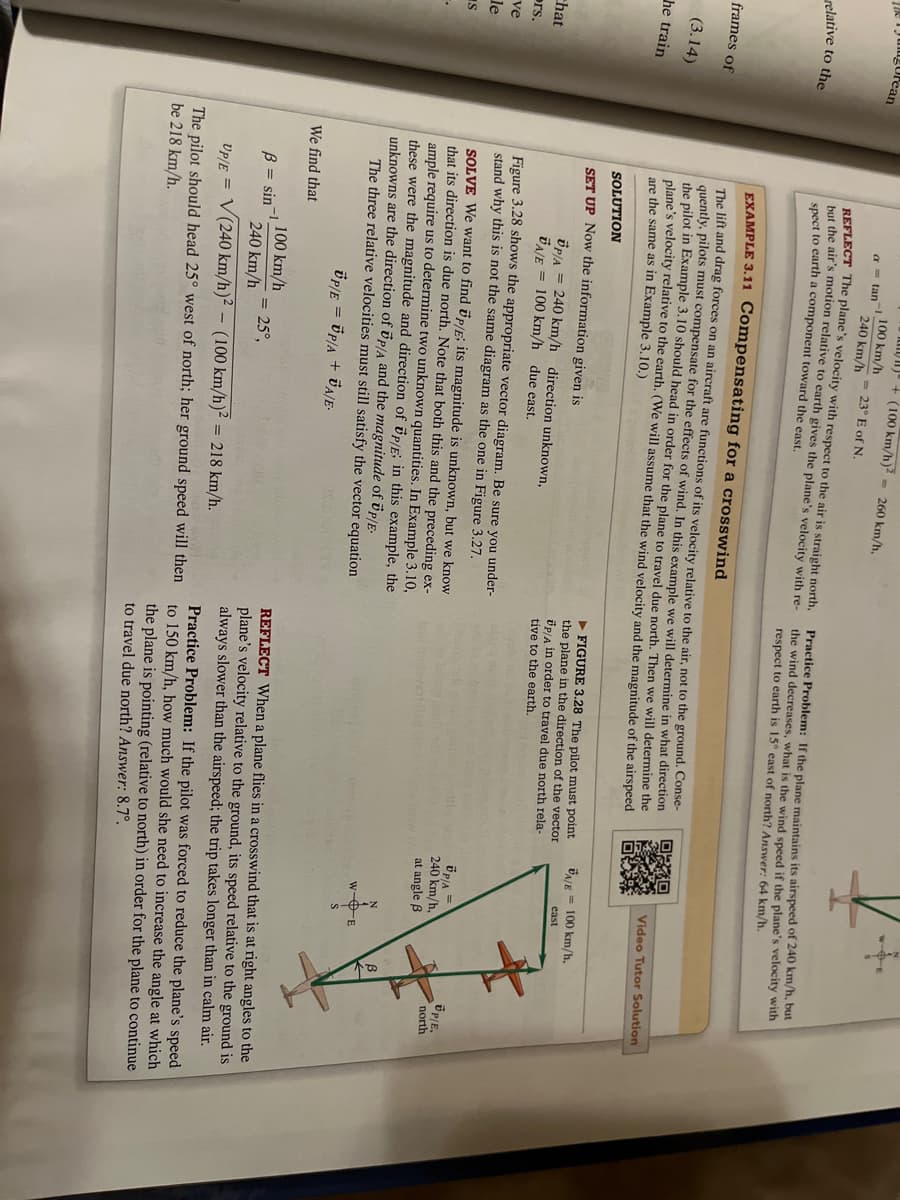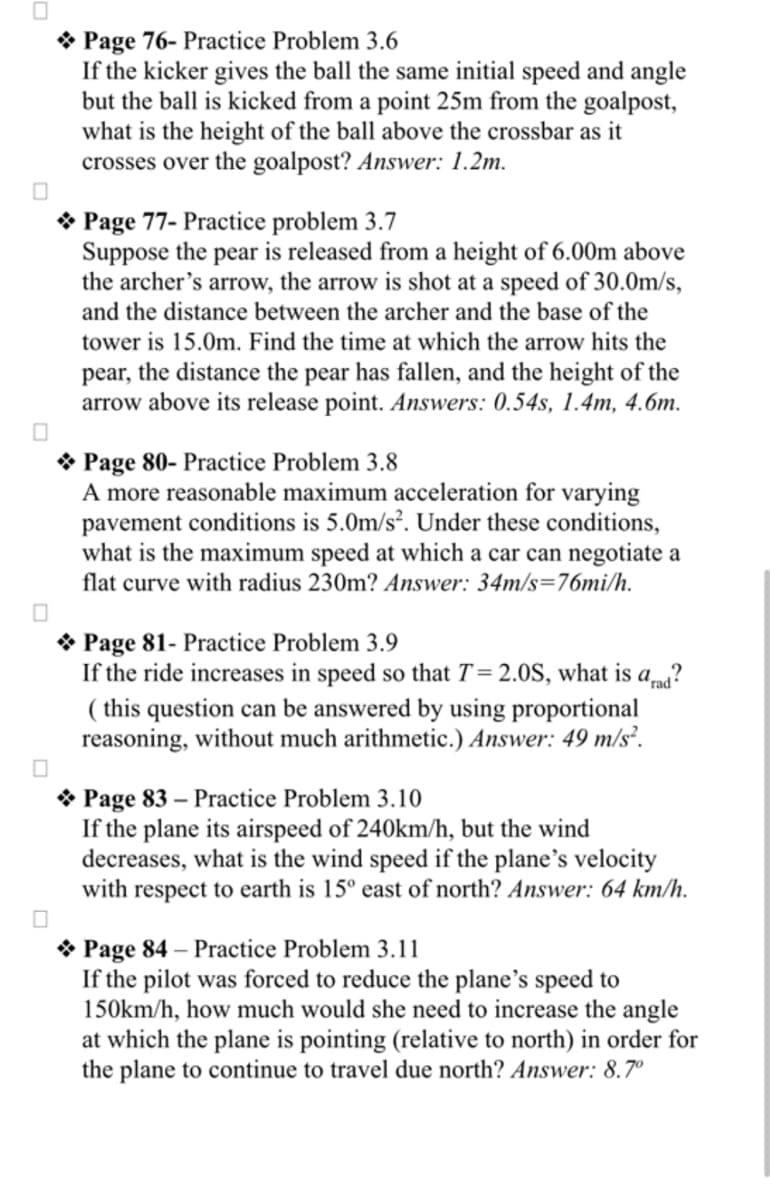If the pilot was forced to reduce the plane's speed to 150km/h, how much would she need to increase the angle at which the plane is pointing (relative to north) in order for the plane to continue to travel due north? Answer: 8.7°
If the pilot was forced to reduce the plane's speed to 150km/h, how much would she need to increase the angle at which the plane is pointing (relative to north) in order for the plane to continue to travel due north? Answer: 8.7°
College Physics
1st Edition
ISBN:9781938168000
Author:Paul Peter Urone, Roger Hinrichs
Publisher:Paul Peter Urone, Roger Hinrichs
Chapter3: Two-dimensional Kinematics
Section: Chapter Questions
Problem 14CQ: Answer the following questions for projectile motion on level ground assuming negligible air...
Related questions
Question
Only practice problem 3.11.
The second photo has background info to help solve the problem.

Transcribed Image Text:relative to the
frames of
gorean
(3.14)
he train
that
prs.
ve
le
S
-.
a tan
REFLECT The plane's velocity with respect to the air is straight north,
but the air's motion relative to earth gives the plane's velocity with re-
spect to earth a component toward the east.
EXAMPLE 3.11 Compensating for a crosswind
The lift and drag forces on an aircraft are functions of its velocity relative to the air, not to the ground. Conse-
quently, pilots must compensate for the effects of wind. In this example we will determine in what direction
the pilot in Example 3.10 should head in order for the plane to travel due north. Then we will determine the
plane's velocity relative to the earth. (We will assume that the wind velocity and the magnitude of the airspeed
are the same as in Example 3.10.)
SOLUTION
SET UP Now the information given is
We find that
B = sin
H)+(100 km/h)2= 260 km/h,
= 23° E of N.
100 km/h
240 km/h
Figure 3.28 shows the appropriate vector diagram. Be sure you under-
stand why this is not the same diagram as the one in Figure 3.27.
1.
SOLVE We want to find üp/E; its magnitude is unknown, but we know
that its direction is due north. Note that both this and the preceding ex-
ample require us to determine two unknown quantities. In Example 3.10,
these were the magnitude and direction of UP/E; in this example, the
unknowns are the direction of P/A and the magnitude of P/E-
The three relative velocities must still satisfy the vector equation
ÜP/E = UP/A + UA/E-
OP/A = 240 km/h direction unknown,
VA/E = 100 km/h due east.
100 km/h
240 km/h
= 25°,
Practice Problem: If the plane maintains its airspeed of 240 km/h, but
the wind decreases, what is the wind speed if the plane's velocity with
respect to earth is 15° east of north? Answer: 64 km/h.
UP/E = V(240 km/h)2 - (100 km/h)² = 218 km/h.
The pilot should head 25° west of north; her ground speed will then
be 218 km/h.
► FIGURE 3.28 The pilot must point
the plane in the direction of the vector
ÜP/A in order to travel due north rela-
tive to the earth.
Video Tutor Solution
VA/E = 100 km/h,
east
UP/A =
240 km/h,
at angle B
WE
UP/E,
north
REFLECT When a plane flies in a crosswind that is at right angles to the
plane's velocity relative to the ground, its speed relative to the ground is
always slower than the airspeed; the trip takes longer than in calm air.
Practice Problem: If the pilot was forced to reduce the plane's speed
to 150 km/h, how much would she need to increase the angle at which
the plane is pointing (relative to north) in order for the plane to continue
to travel due north? Answer: 8.7°.

Transcribed Image Text:Page 76- Practice Problem 3.6
If the kicker gives the ball the same initial speed and angle
but the ball is kicked from a point 25m from the goalpost,
what is the height of the ball above the crossbar as it
crosses over the goalpost? Answer: 1.2m.
Page 77- Practice problem 3.7
Suppose the pear is released from a height of 6.00m above
the archer's arrow, the arrow is shot at a speed of 30.0m/s,
and the distance between the archer and the base of the
tower is 15.0m. Find the time at which the arrow hits the
pear, the distance the pear has fallen, and the height of the
arrow above its release point. Answers: 0.54s, 1.4m, 4.6m.
Page 80-Practice Problem 3.8
A more reasonable maximum acceleration for varying
pavement conditions is 5.0m/s². Under these conditions,
what is the maximum speed at which a car can negotiate a
flat curve with radius 230m? Answer: 34m/s=76mi/h.
Page 81- Practice Problem 3.9
If the ride increases in speed so that T = 2.0S, what is a rad?
(this question can be answered by using proportional
reasoning, without much arithmetic.) Answer: 49 m/s².
Page 83 - Practice Problem 3.10
If the plane its airspeed of 240km/h, but the wind
decreases, what is the wind speed if the plane's velocity
with respect to earth is 15° east of north? Answer: 64 km/h.
Page 84 - Practice Problem 3.11
If the pilot was forced to reduce the plane's speed to
150km/h, how much would she need to increase the angle
at which the plane is pointing (relative to north) in order for
the plane to continue to travel due north? Answer: 8.7°
Expert Solution
This question has been solved!
Explore an expertly crafted, step-by-step solution for a thorough understanding of key concepts.
This is a popular solution!
Trending now
This is a popular solution!
Step by step
Solved in 3 steps with 3 images

Knowledge Booster
Learn more about
Need a deep-dive on the concept behind this application? Look no further. Learn more about this topic, physics and related others by exploring similar questions and additional content below.Recommended textbooks for you

College Physics
Physics
ISBN:
9781938168000
Author:
Paul Peter Urone, Roger Hinrichs
Publisher:
OpenStax College

Principles of Physics: A Calculus-Based Text
Physics
ISBN:
9781133104261
Author:
Raymond A. Serway, John W. Jewett
Publisher:
Cengage Learning

College Physics
Physics
ISBN:
9781305952300
Author:
Raymond A. Serway, Chris Vuille
Publisher:
Cengage Learning

College Physics
Physics
ISBN:
9781938168000
Author:
Paul Peter Urone, Roger Hinrichs
Publisher:
OpenStax College

Principles of Physics: A Calculus-Based Text
Physics
ISBN:
9781133104261
Author:
Raymond A. Serway, John W. Jewett
Publisher:
Cengage Learning

College Physics
Physics
ISBN:
9781305952300
Author:
Raymond A. Serway, Chris Vuille
Publisher:
Cengage Learning

Physics for Scientists and Engineers, Technology …
Physics
ISBN:
9781305116399
Author:
Raymond A. Serway, John W. Jewett
Publisher:
Cengage Learning